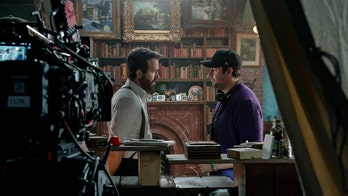Filmmaker James Cameron's trip to the darkest depths of the ocean could have turned into a horror movie.
Cameron surfaced three hours earlier than planned Monday after hydraulic fluid started leaking in his sub.
The descent took 156 minutes, but after he noticed the fluid leak, Cameron decided to end the mission early and his ascent took just 70 minutes.
"I saw a lot of hydraulic oil come up in front of the port. The port got coated with it. I couldn't pick anything up, so I began to feel like it was a moment of diminishing returns to go on," he said. "I lost a lot of thrusters. I lost the whole starboard side. That's when I decided to come up. I couldn't go any further -- I was just spinning in a circle."
PHOTOS: James Cameron's Deepsea Adventure.
Cameron had told The Associated Press in an interview after a 5.1 mile-deep practice run near Papua New Guinea earlier this month that the water pressure at these massive depths "is in the back of your mind." The submarine would implode in an instant if it leaked, he said.
Luckily, his hydraulic leak was less serious. His sub was spotted by helicopter and he was picked up by the support vessel the Mermaid Sapphire shortly afterward.
Cameron, 57, was the first adventurer to make a solo journey to the deepest point on the ocean's floor, reaching a depth of 35,756 feet.
He described diving to a depth of nearly seven miles in the 12-ton Deepsea Challenger as a "heckuva ride" after resurfacing in the Pacific Ocean, 300 miles southwest of Guam, on Monday morning.
"It was bleak. It looked like the moon. I didn't see a fish... I didn't find anything that looked alive to me, other than a few [shrimplike] amphipods in the water," he said. "I didn't feel like I got to a place where I could take interesting geology samples or found anything interesting biologically."
The "Titanic" and "Avatar" director had planned on spending six hours on the ocean floor collecting samples and sent a tweet after reaching the Challenger Deep undersea valley in the Mariana Trench.
"Just arrived at the ocean's deepest [point]. Hitting bottom never felt so good. Can't wait to share what I'm seeing [with] you," Cameron said in the tweet.
Cameron hinted that he could carry out another dive to the trench in the future. He said, "Next dive. Gotta leave something for the next one."
Others paid tribute to his bravery.
"@JimCameron has surfaced! Congrats to him on his historic solo dive to the ocean's deepest point," said organizers of his mission, Deep Sea Challenge, at 10:03pm ET Sunday.
Arnold Schwarzenegger, who was directed by Cameron in the "Terminator" films, was among the first to congratulate Cameron, tweeting, "Congrats to my great friend on the deepest solo dive ever. Always a pioneer."
Cameron embarked on the solo trip in a sub that he has described as a "vertical torpedo," outfitted with 3D cameras and a tower of LED bulbs to capture video footage of the alien world, some 35,800 feet (10,900 meters) below the surface. He also collected samples.
National Geographic will chronicle the adventure in 3D at theaters and later on TV.
In addition to studying deep ocean science, he had been training for the physical challenges of the mission -- running several miles a day, practicing yoga and preparing to deal with the sub's cramped quarters.
No one has been to Challenger Deep since Jacques Piccard and Don Walsh made the descent in a 1960 expedition for the US Navy. Their stay only lasted about 20 minutes and did not allow for the type of extensive study that Cameron planned.
The scale of the trench is hard to grasp -- it's 120 times larger than the Grand Canyon and more than a mile deeper than Mount Everest is tall.
The film director has been an oceanography enthusiast since childhood and has made 72 deep-sea submersible dives. Thirty-three of those dives have been to the wreckage of the Titanic, the subject of his 1997 hit film, which is being released in a 3-D version next month.
The Associated Press and NewsCore contributed to this report.






